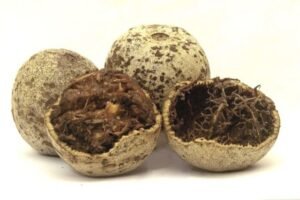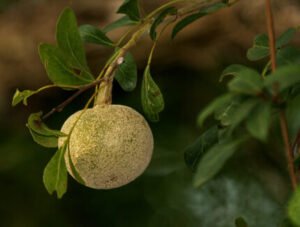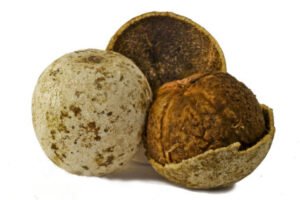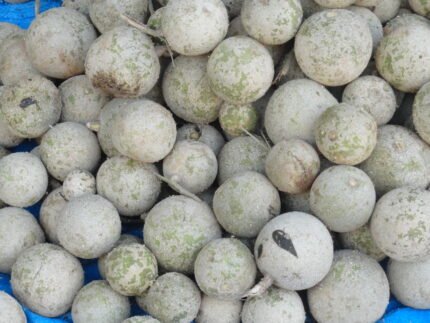Medically reviewed by Dr. Ramesh Gaddam, M.D. — Written by Sumalatha, D.N.H.E
What is Wood Apple?
Wood apple, also known as “Bael” or “Aegle marmelos,” is a tropical fruit that is native to India and is also found in other parts of South Asia. This fruit is known for its unique shape, hard and woody outer shell, and aromatic pulp.
The wood apple fruit is typically round and has a hard, woody shell with a rough texture. The outer shell can be challenging to crack open. The inner pulp of the wood apple is aromatic and has a sweet, tangy, and somewhat astringent flavor. It can vary in color from yellow to brown.
Wood Apple Nutrition
Nutritional content of wood apple (per 100 grams):
| Nutrient
| Amount per 100g |
|---|---|
| Calories | 137 kcal |
| Carbohydrates | 31.8 g |
| Fiber | 2.5 g |
| Sugars | 26.3 g |
| Protein | 1.8 g |
| Fat | 0.39 g |
| Vitamin C | 8.7 mg |
| Vitamin A | 85 IU |
| Calcium | 85 mg |
| Iron | 1.7 mg |
| Phosphorus | 80 mg |
| Potassium | 600 mg |
| Magnesium | 32 mg |
Wood Apple Benefits

Digestive Health:
Wood apple is well-known for its digestive benefits. It can help alleviate various digestive issues, including indigestion, constipation, and diarrhea. The fruit is often used to make a digestive tonic.
Rich in Fiber:
Wood apple is a good source of dietary fiber, which can promote regular bowel movements, prevent constipation, and maintain a healthy digestive system.
Immune System Support:
The fruit contains vitamin C, which can boost the immune system and help the body fight off infections and illnesses.
Aid for Diabetics:
Some studies suggest that wood apple may help regulate blood sugar levels, making it potentially beneficial for people with diabetes.
Respiratory Health:
Wood apple is traditionally used to treat respiratory problems such as asthma and cough. The pulp can be consumed to soothe respiratory issues.
Anti-inflammatory Properties:
It is believed to have anti-inflammatory properties and can be used to reduce inflammation in various parts of the body.
Heart Health:
The fruit contains potassium and may help maintain healthy blood pressure levels, reducing the risk of heart diseases.
Anti-Microbial:
Wood apple possesses antimicrobial properties and can help in fighting off various bacterial and fungal infections.
Skin Health:
The antioxidants in wood apple may help maintain healthy skin and prevent premature aging. The pulp can also be used topically as a natural skincare treatment.
Weight Management:
Due to its high fiber content, wood apple can help you feel full and satisfied, which may aid in weight management and preventing overeating.
Reduces Gastric Problems:
Wood apple is known for its ability to reduce acidity and gastric ulcers. It can have a soothing effect on the stomach lining.
Traditional Medicine:
Wood apple has been used in traditional medicine systems like Ayurveda for a wide range of health issues, from snakebites to liver problems.
Wood Apple Uses

Wood apple, also known as Bael fruit, has a variety of traditional and culinary uses due to its unique flavor and potential health benefits. Here are some common uses of wood apple and how to eat wood apple.
Fresh Consumption:
The most straightforward use of wood apple is to consume the pulp. You can cut the fruit open, scoop out the pulp, and eat it directly. The pulp has a sweet, tangy flavor and is a popular snack in many South Asian countries.
Juice:
Wood apple pulp can be blended with water and strained to make a refreshing and nutritious drink. Wood apple juice is not only tasty but also a natural remedy for various digestive issues.
Sherbet:
Wood apple sherbet is a popular beverage made by diluting wood apple pulp with water, adding sugar or honey, and sometimes spicing it up with ingredients like cardamom. It’s a soothing and cooling drink, especially in hot weather.
Chutney:
Wood apple chutney is made by mixing the pulp with sugar, salt, and spices. It can be served as a condiment alongside various dishes or used as a dip.
Jams and Preserves:
Wood apple pulp can be used to make jams and preserves. Sugar is added to the pulp, and it is cooked to create a thick, sweet spread for bread or other dishes.
Ayurvedic Medicine:
In traditional Ayurvedic medicine, various parts of the wood apple tree, including the leaves, roots, and bark, are used for their potential medicinal properties. These parts are used in the preparation of herbal remedies to treat a range of ailments.
Face Masks:
The pulp of wood apple can be used as a natural skincare treatment. It’s believed to help improve skin texture and complexion when applied as a face mask.
Religious Offerings:
In Hinduism, wood apple is considered sacred and is often offered to Lord Shiva. It is used as a religious offering in temples and during rituals.
Culinary Dishes:
Wood apple pulp can be incorporated into various dishes, both savory and sweet. It can be used in curries, desserts, and as a flavoring in some regional cuisines.
Natural Air Freshener:
The dried rind of the wood apple can be used as a natural air freshener. It has a pleasant, woody aroma and is often placed in closets or rooms to add a refreshing scent.
Medicinal Infusions:
Infusions or decoctions made from the leaves, roots, or bark of the wood apple tree are used in traditional medicine to treat specific health issues.
Wood apple side effects

Allergic Reactions:
Some individuals may be allergic to wood apple. Allergic reactions can include skin rashes, itching, or swelling. If you are trying wood apple for the first time, consume a small amount to see if you have any adverse reactions.
Diarrhea:
While wood apple is often used to treat diarrhea and digestive issues, consuming it in excessive amounts may lead to diarrhea in some people. It’s important to eat it in moderation.
High in Sugar:
Wood apple is relatively high in natural sugars, which can be a concern for individuals with diabetes or those trying to manage their blood sugar levels. If you have diabetes, monitor your blood sugar after consuming wood apple and adjust your intake accordingly.
Tooth Decay:
Like many fruits, wood apple contains sugars that can contribute to tooth decay if proper oral hygiene is not maintained. It’s a good practice to rinse your mouth with water after consuming wood apple to reduce the risk of dental issues.
Weight Gain:
If consumed excessively, wood apple can contribute to weight gain due to its calorie content and sugar content. It’s important to include it as part of a balanced diet and not overindulge.
Medication Interactions:
Wood apple may interact with certain medications. If you are taking prescription drugs, especially those related to blood sugar or blood pressure, consult with a healthcare professional before adding wood apple to your diet to ensure there are no adverse interactions.
Digestive Upset:
While wood apple is known for its digestive benefits, in some cases, excessive consumption can lead to stomach discomfort or bloating. It’s best to consume it in moderation.
Not Suitable for Some Medical Conditions:
Individuals with certain medical conditions, such as kidney problems, should consult with a healthcare provider before adding wood apple to their diet, as its high potassium content may not be suitable for them.
Seed Toxicity:
The seeds inside the wood apple should not be consumed, as they are toxic. Make sure to remove and discard the seeds when eating the fruit or using it in recipes.
Wood apple varieties

Wood apple, also known as Bael fruit, has several varieties and cultivars, each with its own unique characteristics. The specific varieties may vary by region and climate. Here are a few notable wood apple varieties:
- Common Bael (Aegle marmelos):
This is the most widely recognized and commonly cultivated variety of wood apple. It is known for its hard, woody shell and aromatic, sweet-tasting pulp. Common Bael is native to India and is found in various parts of South Asia.
- Hill Bael (Aegle marmelos subsp. maderaspatana):
This variety is commonly found in hilly regions and has adapted to different climatic conditions. It is often smaller in size compared to the common variety and has a slightly different taste.
- Kagzi Bael:
Kagzi means “paper-like” in Hindi, and this variety is named for its thin and smoother outer shell compared to the common Bael. The pulp of Kagzi Bael is also considered more aromatic and flavorful.
- Darbhanga Bael:
This is a specific variety of Bael fruit that is cultivated in the Darbhanga region of Bihar, India. It is known for its large fruit size and high-quality pulp.
- Bengal Bael:
This variety is cultivated in the Bengal region of India and is known for its sweet and aromatic pulp. It is often used to make wood apple-based sweets and desserts.
- Sri Lankan Bael (Aegle marmelos var. marmelos):
This variety is found in Sri Lanka and has smaller fruit compared to the common Bael. The Sri Lankan Bael is known for its aromatic and flavorful pulp, often used in traditional Sri Lankan cuisine.
- Burmese Bael (Aegle marmelos var. suaveolens):
This variety is found in Myanmar (Burma) and is known for its slightly different taste and aroma. It is used in Burmese culinary preparations.
- Nepalese Bael:
This variety is found in Nepal and is used in various culinary dishes, including traditional Nepalese desserts and snacks.
These are just a few of the many wood apple varieties that exist. Each variety may have subtle differences in flavor, size, and adaptability to specific regions. The choice of variety often depends on local availability and regional preferences for culinary or medicinal uses.
Wood apple juice

Wood apple juice, often known as Bael juice, is a popular and refreshing beverage in South Asia. It is made from the pulp of the wood apple fruit (Aegle marmelos) and is known for its sweet, tangy, and slightly astringent flavor. Here’s how you can make wood apple juice:
Ingredients:
- 1 ripe wood apple (Bael fruit)
- Sugar or honey (optional, to taste)
- Water
Instructions:
- Select a Ripe Wood Apple: Choose a ripe wood apple with a hard, woody shell that feels heavy for its size. Ripe wood apples typically have a sweet aroma.
- Prepare the Wood Apple: Wash the wood apple thoroughly to remove any dirt or impurities. Then, use a sharp knife to cut off the top part of the fruit.
- Extract the Pulp: The hard shell can be challenging to crack open, so you can use a heavy knife or a hammer to carefully break it open. Once the shell is cracked, you’ll see the aromatic pulp inside. Scoop out the pulp using a spoon or your hands, and place it in a bowl. Discard the seeds and any hard fibers.
- Blend the Pulp: Transfer the wood apple pulp to a blender. Add a bit of water to help with the blending process. Blend until you have a smooth, thick puree.
- Strain the Juice: To remove any remaining seeds or coarse fibers, strain the blended pulp through a fine-mesh sieve or cheesecloth into a clean container. Press down on the pulp to extract as much juice as possible.
- Sweeten (Optional): Taste the juice. If it’s too tart for your liking, you can add sugar or honey to sweeten it. Start with a small amount and adjust to your preference.
- Dilute with Water: Wood apple juice is often concentrated and can be quite thick. To make it a refreshing drink, dilute it with cold water according to your taste. You can use a 1:1 ratio of wood apple pulp to water as a starting point and adjust as needed.
- Chill and Serve: Refrigerate the wood apple juice for a few hours to chill it. Serve the chilled juice in glasses with ice cubes, if desired.
Wood apple juice is not only delicious but is also known for its digestive and nutritional benefits. It can be consumed as a cooling drink during hot weather or as a remedy for various digestive issues. Enjoy this refreshing beverage as part of your diet for a taste of South Asian culinary tradition.
Wood apple benefits for skin
- Antioxidant Properties: Wood apple is rich in antioxidants, such as vitamin C and other phytochemicals. Antioxidants help combat free radicals, which can damage skin cells and lead to premature aging. Consuming wood apple can contribute to healthier, more youthful-looking skin.
- Skin Hydration: The high water content in wood apple can help keep the skin hydrated. Proper skin hydration is essential for maintaining its elasticity and preventing dryness and flakiness.
- Anti-Inflammatory Effects: Wood apple is believed to have anti-inflammatory properties. These properties may help reduce skin inflammation and redness, making it potentially useful for people with sensitive or irritated skin.
- Skin Cleansing: The pulp of wood apple can be used topically as a natural cleanser. It can help remove dirt, oil, and impurities from the skin, leaving it clean and refreshed.
- Exfoliation: The slightly grainy texture of the pulp can be used for gentle exfoliation. This can help remove dead skin cells and promote a smoother complexion.
- Skin Brightening: Some traditional remedies use wood apple to brighten the skin and improve its texture. It is believed to help reduce the appearance of blemishes and uneven skin tone.
- Soothing Irritated Skin: The cooling and soothing properties of wood apple make it useful for calming irritated or sunburned skin. It can help reduce redness and discomfort.
- Natural Moisturizer: Wood apple pulp can be used as a natural moisturizer. It can be applied to dry or rough patches of skin to help soften and hydrate.
- Fights Skin Infections: Wood apple is known for its antimicrobial properties. It may help in preventing or treating skin infections caused by bacteria or fungi.
- Anti-Acne Properties: Some people use wood apple pulp as a natural remedy for acne. Its cleansing and anti-inflammatory properties may help in managing acne-prone skin.
Wood apple benefits for hair
- Rich in Vitamins and Minerals: Wood apple is a good source of vitamins and minerals, including vitamin C, vitamin A, calcium, and iron. These nutrients are important for maintaining healthy hair and promoting hair growth.
- Antioxidant Properties: The antioxidants in wood apple can help protect your hair and scalp from oxidative stress caused by free radicals. This protection can prevent damage to hair follicles and support overall hair health.
- Boosts Immune System: A strong immune system is essential for maintaining healthy hair. Vitamin C in wood apple can help boost your immunity, which, in turn, can promote healthy hair growth.
- Scalp Health: Wood apple has cooling and anti-inflammatory properties that can help soothe an itchy or irritated scalp. It may also aid in reducing dandruff and dryness.
- Aids Digestion: Proper digestion is linked to overall health, including the health of your hair. Wood apple is known for its digestive benefits, and a healthy gut can positively impact your hair.
- Hair Hydration: The high water content in wood apple can contribute to hair hydration. Adequate moisture is important for preventing dryness and maintaining the elasticity of hair.
- Improved Blood Circulation: Some traditional remedies use wood apple to enhance blood circulation. Good blood flow to the scalp ensures that hair follicles receive essential nutrients and oxygen for optimal growth.
- Stress Reduction: Wood apple has a calming effect on the nervous system. Reducing stress can prevent hair loss and promote hair growth.
Wood apple medicinal uses
- Digestive Aid: Wood apple is well-known for its digestive benefits. It can help alleviate digestive problems such as indigestion, constipation, and diarrhea. Consuming the pulp or wood apple-based products like sherbet can aid in digestion.
- Diarrhea and Dysentery: Wood apple is traditionally used to treat diarrhea and dysentery. The astringent properties of the fruit’s pulp are thought to help reduce loose stools and improve bowel regularity.
- Gastric Ulcers: Wood apple is used in Ayurvedic medicine to soothe gastric ulcers. The fruit’s cooling and soothing properties may help reduce the discomfort associated with ulcers.
- Respiratory Issues: Wood apple is believed to have properties that can help with respiratory problems. It is used as a remedy for conditions such as asthma and cough.
- Antimicrobial Effects: The fruit is considered to have antimicrobial properties, making it useful for fighting off bacterial and fungal infections.
- Immune System Support: The vitamin C content in wood apple can boost the immune system, helping the body defend against infections and illnesses.
- Anti-Inflammatory: Wood apple is believed to have anti-inflammatory properties and is used to reduce inflammation in various parts of the body.
- Urinary Disorders: In traditional medicine, wood apple is used to treat urinary disorders and infections.
- Skin Ailments: The pulp of wood apple can be used topically to treat skin conditions. It may help with skin irritations, rashes, and wounds. It is also used to improve skin texture and complexion.
- Liver Disorders: Wood apple is considered to have hepatoprotective properties and is used in Ayurvedic medicine to manage liver disorders.
- Antipyretic (Fever-Reducing): Wood apple is sometimes used to reduce fever. The cooling effect of the fruit is thought to help lower body temperature.
- Cardiovascular Health: Some traditional remedies use wood apple to support heart health and manage cardiovascular conditions. The potassium content in the fruit may help regulate blood pressure.
Wood apple benefits weight loss
- Dietary Fiber: Wood apple is rich in dietary fiber, with approximately 2.5 grams of fiber per 100 grams of fruit. Fiber promotes feelings of fullness, which can help reduce overeating and snacking between meals. This can be helpful for controlling calorie intake and supporting weight loss.
- Digestive Health: Wood apple is well-known for its digestive properties. It can aid in relieving issues like indigestion and constipation. A healthy digestive system is crucial for efficient nutrient absorption and overall well-being. When your digestive system functions optimally, it can contribute to weight management.
- Reduced Bloating: Wood apple’s anti-flatulent properties may help reduce bloating and discomfort. When you feel less bloated, it can be easier to maintain a healthy and balanced diet.
- Hydration: The high water content of wood apple can contribute to overall hydration. Proper hydration is essential for various bodily functions, including metabolism and energy production.
- Reduced Sugar Cravings: The natural sweetness of wood apple can help satisfy sugar cravings in a healthier way. Choosing natural sugars over processed sugary snacks can aid in weight management.
- Nutrient Density: Wood apple provides essential vitamins and minerals, which can support overall health and energy levels while you are on a weight loss journey.
- Blood Sugar Regulation: Some studies suggest that wood apple may help regulate blood sugar levels. Stable blood sugar levels can help prevent sudden spikes and crashes in energy, making it easier to stick to a weight loss plan.
Wood apple benefits for diabetes
- Blood Sugar Regulation: Some studies suggest that wood apple may have a positive effect on blood sugar regulation. The fruit’s fiber content, along with certain phytochemicals, may help slow down the absorption of sugar in the digestive system, preventing rapid spikes in blood sugar levels after meals.
- Low Glycemic Index: Wood apple has a relatively low glycemic index (GI). Foods with a low GI release glucose slowly into the bloodstream, which can help stabilize blood sugar levels. This can be beneficial for people with diabetes to manage their condition.
- Fiber Content: Wood apple is rich in dietary fiber, which can slow the digestion of carbohydrates and help prevent rapid increases in blood sugar. It can also promote a feeling of fullness, reducing the temptation to snack on high-sugar foods.
- Rich in Antioxidants: The antioxidants in wood apple, including vitamin C, can help reduce oxidative stress and inflammation, which are associated with diabetes complications. Managing oxidative stress is essential for overall health, particularly for individuals with diabetes.
- Improved Digestive Health: Wood apple is known for its digestive properties. A healthy digestive system can enhance the absorption of nutrients, including glucose, and promote better blood sugar control.
- Weight Management: The high fiber content in wood apple can help with weight management, and maintaining a healthy weight is crucial for diabetes management. Excess weight can make it more challenging to control blood sugar levels.
- Alternative to Sugary Snacks: The natural sweetness of wood apple can serve as a healthier alternative to sugary snacks, reducing the intake of empty calories and refined sugars.
Wood apple benefits in pregnancy
- Nutrient-Rich: Wood apple is a good source of essential vitamins and minerals, including vitamin C, vitamin A, calcium, iron, and dietary fiber. These nutrients are important for the overall health and well-being of both the mother and the developing fetus.
- Digestive Health: Wood apple is well-known for its digestive properties and may help alleviate common pregnancy-related digestive issues such as constipation and indigestion. The dietary fiber in wood apple can promote regular bowel movements.
- Hydration: The high water content in wood apple can help maintain proper hydration during pregnancy, which is essential for overall health and well-being.
- Preventing Nausea: Some pregnant women experience nausea and morning sickness. Wood apple’s natural sweetness and cooling properties may help soothe an upset stomach and reduce nausea.
- Immune Support: The vitamin C content in wood apple can boost the immune system, helping the pregnant woman’s body fight off infections and illnesses.
- Anti-Inflammatory Properties: Wood apple is believed to have anti-inflammatory properties that may help reduce inflammation and discomfort during pregnancy.
- Preventing Gestational Diabetes: Some studies suggest that the low glycemic index of wood apple can help stabilize blood sugar levels, which can be beneficial for preventing gestational diabetes.
Wood apple benefits for sperm
Wood apple contains certain nutrients and properties that can contribute to overall well-being, which may indirectly benefit sperm health. Here are some ways in which wood apple may be indirectly beneficial:
- Nutrient Content: Wood apple is a source of various essential vitamins and minerals, including vitamin C, vitamin A, calcium, and iron. These nutrients play a role in overall health and may contribute to overall well-being.
- Antioxidants: The antioxidants in wood apple, such as vitamin C, can help reduce oxidative stress, which can impact sperm health and motility.
- Digestive Health: Wood apple is known for its digestive benefits. A healthy digestive system can support the absorption of essential nutrients, which is important for overall health.
- Immune Support: The vitamin C in wood apple can boost the immune system, helping to protect the body from infections and illnesses that might affect overall health.
- Anti-Inflammatory Properties: Wood apple is believed to have anti-inflammatory properties. Reducing inflammation can benefit overall health and potentially contribute to improved sperm health.
It’s important to note that sperm health is influenced by a variety of factors, including genetics, lifestyle, and overall health. While a balanced diet that includes nutrient-rich foods like wood apple can contribute to overall well-being, it’s not a standalone solution for addressing specific concerns related to sperm health or fertility.
If you have concerns about sperm health or fertility, it’s advisable to consult with a healthcare professional or a fertility specialist who can provide personalized guidance and recommendations to address your specific needs and any potential underlying issues.
What is wood apple good for?
Wood apple is known for its potential digestive benefits. It can help with issues like indigestion, constipation, and diarrhea.
It’s a good source of dietary fiber, which can promote regular bowel movements.
Wood apple is also believed to have immune-boosting properties due to its vitamin C content.
Can we drink wood apple juice daily?
Yes, you can drink wood apple juice daily, but like with any food or beverage, moderation is key. It can be a refreshing and nutritious addition to your daily diet. However, excessive consumption may lead to digestive discomfort.
Is wood apple good for heat or cold?
Wood apple is considered a cooling fruit and is often consumed to beat the heat, especially in hot weather. It is believed to have a cooling effect on the body and is used to relieve heat-related discomfort.
Is wood apple good for blood pressure?
Wood apple contains potassium, which can help regulate blood pressure. Potassium is known to counter the effects of sodium in the body, potentially leading to lower blood pressure. However, it should be consumed as part of a balanced diet, and if you have hypertension or are on medication, consult a healthcare professional.
Can we eat wood apple daily?
You can eat wood apple in moderation as part of your daily diet. However, excessive consumption may lead to digestive issues.
What are the side effects of wood apples?
Potential side effects of wood apple consumption can include allergies, diarrhea (if consumed in excess), and digestive discomfort. It’s crucial to consume it in moderate amounts and be mindful of any adverse reactions.
Can diabetics eat wood apple?
Wood apple can be included in the diet of people with diabetes, but it should be consumed in moderation. While it may have blood sugar-regulating properties, individuals with diabetes should monitor their blood sugar levels and consult with a healthcare provider to ensure it fits into their dietary plan.
Is wood apple good for fatty liver?
There is no direct evidence to suggest that wood apple is specifically beneficial for fatty liver. A balanced diet, exercise, and medical advice are typically recommended for managing fatty liver disease.
Is wood apple good for uric acid?
Wood apple is generally considered safe for individuals with high uric acid levels. It’s not specifically known to either increase or decrease uric acid levels. However, if you have gout or high uric acid levels, it’s important to manage your diet and consult a healthcare professional for guidance.
Can we keep wood apple in the fridge?
Yes, you can store wood apples in the fridge to keep them fresh for a longer period. Refrigeration can help prolong their shelf life and maintain their quality. You can store whole wood apples or cut them into sections and store them in an airtight container in the fridge.
Is banana high in uric acid?
Bananas are generally considered low in purines, which are substances that can contribute to uric acid production. Therefore, they are often considered safe for individuals with gout or high uric acid levels. However, individual reactions can vary, so it’s a good idea to monitor your own response to bananas if you have concerns about uric acid.
Is wood apple good for cholesterol?
Wood apple is not particularly known for its cholesterol-lowering properties. It is more recognized for its potential digestive and immune-boosting benefits. For managing cholesterol levels, a diet rich in fiber, whole grains, fruits, vegetables, and foods low in saturated and trans fats is generally recommended.
Is wood apple rich in calcium?
Wood apple does contain calcium, but it is not an exceptionally rich source of this mineral. If you’re looking to increase your calcium intake, you may want to consider other foods like dairy products, leafy greens, and fortified foods.
Can we eat unripe wood apple?
Unripe wood apples are not commonly consumed because they are hard, astringent, and less palatable. It’s the ripe fruit with sweet and aromatic pulp that is typically eaten.
What is the acidity of wood apple?
Wood apple is known for its slightly astringent and tangy flavor, which can give it a mild acidic taste. This acidity is part of what makes it refreshing and beneficial for digestion.
Is wood apple allergic?
Some individuals may be allergic to wood apple, and allergic reactions can include skin rashes, itching, or swelling. If you are trying wood apple for the first time, consume a small amount to check for any adverse reactions.
Does wood apple cause gas?
In some cases, consuming wood apple pulp in excess may lead to gas or digestive discomfort, especially if your digestive system is not accustomed to it. Eating it in moderation is recommended to minimize the risk of digestive issues.
Is wood apple a false fruit?
Wood apple is not a false fruit. It is a true fruit produced by the wood apple tree (Aegle marmelos). The term “false fruit” is usually applied to fruits like apples, pears, and strawberries, where the fleshy part we typically eat is derived from the receptacle or floral tissue and not the ovary of the flower.
What type of fruit is wood apple?
Wood apple is a drupe fruit. It has a hard, woody shell (the endocarp) that surrounds the pulp and seeds. The pulp is the edible part of the fruit.
Is apple wood heavy?
Apple wood, derived from the apple tree, is moderately dense and has a medium weight. It is often used for smoking and grilling due to its mild, sweet aroma, which imparts a unique flavor to foods. The weight and density of apple wood can vary depending on the specific variety of apple tree and the conditions in which it grows.
Is wood apple fruit or vegetable?
Wood apple is a fruit, not a vegetable. It is often referred to as “Aegle marmelos” in botanical terms.
What is wood apple called in India?
In India, wood apple is commonly known as “Bael” or “Bel.”
Is wood apple good for PCOS?
Wood apple is not a specific treatment for PCOS (Polycystic Ovary Syndrome), but it can be a part of a balanced diet that may be beneficial for overall health. PCOS management typically involves lifestyle modifications, a healthy diet, and medical treatments as advised by a healthcare professional.
Is wood apple tasty?
The taste of wood apple is a matter of personal preference. It has a unique flavor that is sweet, tangy, and slightly astringent. Many people find it tasty, while others may need some time to acquire the taste.
Can I drink wood apple juice at night?
You can drink wood apple juice at night if you enjoy it and it doesn’t cause any discomfort or digestive issues. It can be a refreshing and nutritious evening beverage.
Can we eat wood apple after dinner?
Eating wood apple after dinner is fine as long as it doesn’t lead to digestive discomfort. It can be consumed as a dessert or as a digestive aid.
Where is wood apple found?
Wood apple is primarily found in South Asian countries, including India, Nepal, Sri Lanka, and Myanmar. It is often cultivated in these regions.
How is wood apple eaten?
Wood apple is typically eaten by breaking open the hard, woody shell and scooping out the pulp. The pulp can be consumed directly, or it can be used to make juices, sherbets, chutneys, jams, and various culinary dishes.
What is another name for a wood apple?
Another name for wood apple is “Bael fruit” or simply “Bael.”
Does wood apple grow in India?
Yes, wood apple does grow in India, and it is native to the Indian subcontinent. It is commonly found in various parts of the country and is often cultivated for its culinary and medicinal uses.
In which season do we get wood apple?
Wood apples are typically harvested in India during the summer and monsoon seasons, which roughly correspond to the months of April to September. The specific timing may vary slightly depending on the region and local climate conditions.
Which states produce wood apple in India?
Wood apples are grown in several states across India, including but not limited to:
- Uttar Pradesh: This state is one of the major producers of wood apples in India. It has a significant cultivation of Bael fruit.
- Bihar: Bihar is another significant producer of wood apples, and the fruit is commonly cultivated and consumed in the region.
- Gujarat: Wood apple is grown in parts of Gujarat, and it is used in various culinary preparations.
- Maharashtra: Some regions in Maharashtra also cultivate wood apples, especially in the Konkan region.
- Madhya Pradesh: Wood apple cultivation is seen in parts of Madhya Pradesh.
- West Bengal: The fruit is grown and consumed in West Bengal.
- Rajasthan: Wood apple trees can be found in some parts of Rajasthan.
- Tamil Nadu: In southern India, Tamil Nadu is one of the states where wood apples are cultivated.
These are just a few of the states where wood apples are produced in India. The fruit is widely distributed across the country and is used for various culinary, medicinal, and religious purposes. The specific regions of cultivation may vary within these states due to climate and soil conditions.
Names of wood apple in Indian languages:
- Hindi: Bael (बेल)
- Bengali: Bel (বেল)
- Tamil: Vilam Palam (விளம் பழம்)
- Telugu: Maredu (మారేడు)
- Kannada: Bevu (ಬೇವು)
- Marathi: Bael (बेल)
- Gujarati: Bilva (બિલ્વ)
- Oriya: Kaitha (କଇଠ)
- Punjabi: Bel (ਬੇਲ)
- Malayalam: Koovalam (കൂവളം)
- Assamese: Bael (বেল)
- Urdu: Bel (بیل)
External References
- Healthline: Healthline provides information on the nutritional value and potential health benefits of Wood Apple.
- WebMD: WebMD often has articles and resources related to the health benefits of various foods, including Wood Apple.
- Medical News Today: This source can provide information on the potential medicinal properties of Wood Apple.
- Livestrong: Livestrong often features articles on the health benefits of various foods, including Wood Apple.
Medically reviewed by Dr. Ramesh Gaddam, M.D.

General Physician, Diabetologist, and Critical Care Specialist.
Discover more from Health Build-Up
Subscribe to get the latest posts sent to your email.
